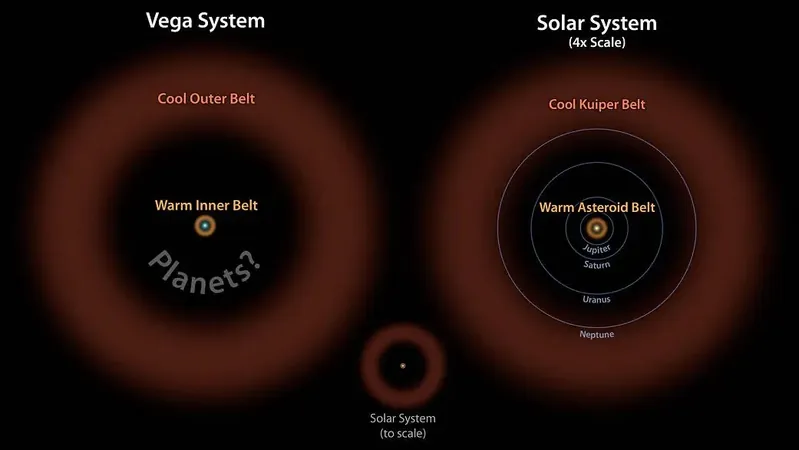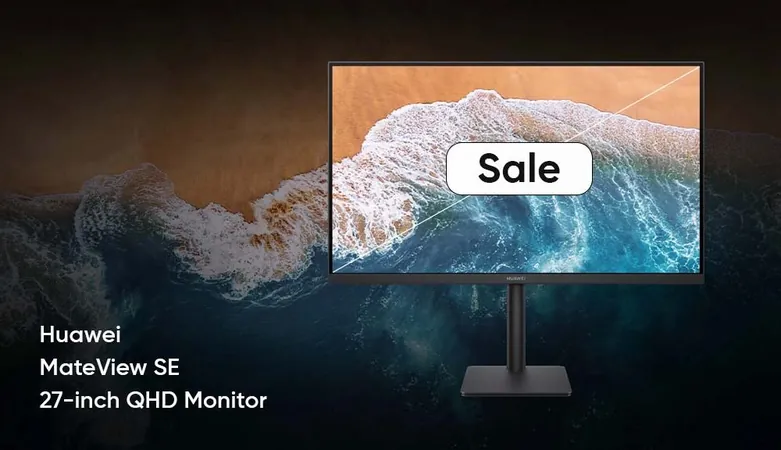
James Webb Space Telescope Probes Vega: Are There Any Planets Hiding in the Shadows?
2024-10-26
Author: Li
Introduction
In the northern summer sky, Vega stands out as one of the brightest stars, widely recognized by stargazers. Located approximately 25 light-years from Earth, Vega is the centerpiece of the constellation Lyra and forms one point of the iconic Summer Triangle alongside Altair in Aquila and Deneb in Cygnus. Not only is this celestial giant a wonder to behold, but it has also piqued the interest of astronomers since 2013 when large rings of rocky debris were detected orbiting it. This tantalizing finding opened the door to the possibility of undiscovered planets surrounding Vega.
The Role of the James Webb Space Telescope
Recently, astronomers turned the advanced James Webb Space Telescope (JWST) toward Vega, hoping to solve the mystery of its potential planetary companions. Launched in December 2021 as a collaborative project between NASA, the European Space Agency (ESA), and the Canadian Space Agency (CSA), the JWST is revolutionizing astronomical research. Situated at a stable point approximately 1.5 million kilometers from Earth, it boasts a 6.5-meter primary mirror, allowing it to outshine its ground-based competitors by capturing clearer, more sensitive data.
Investigating Vega's Surroundings
Using the JWST’s powerful instruments—particularly the Near Infrared Camera (NIRCam) and Mid Infrared Camera (MIRI)—scientists sought to explore the enigmatic debris surrounding Vega. Prior observations from the Infrared Astronomical Satellite (IRAS) indicated an unusual excess of long-wavelength emissions, adding intrigue to Vega’s dusty environment. This signal mirrored those from our solar system's Kuiper Belt, leading astronomers to speculate that the ring of debris might be the result of planetary formation processes.
The Search for Planets
In a groundbreaking study led by Charles Beichman of NASA’s Exoplanet Science Institute, teams analyzed coronagraphic observations from NIRCam. They identified three potential sources within the data, which were further scrutinized with MIRI observations. The hope was that if these sources were indeed part of Vega’s system, they would show a significant mass—between 1 and 3 times that of Jupiter—and a temperature around 250K. However, the results were disheartening; the MIRI data did not reveal any disruptions in the disk structure that would suggest the presence of such celestial bodies.
Conclusion
For now, it appears that Vega may be solitary, lacking a retinue of planets in its debris field. While this setback is disappointing, it does not mean the end of the search for extraterrestrial companions. Future observations with the JWST and upcoming observatories promise new possibilities and insights. The quest to unveil the secrets hidden around Vega continues—will it eventually reveal its cosmic partners, or will it remain a bright star standing alone in the night sky?
Looking Ahead
As astronomers press on in their explorations, one thing is clear: Vega's shining presence reminds us of the mysteries of the universe waiting to be uncovered. Stay tuned as new revelations could be just around the corner!




 Brasil (PT)
Brasil (PT)
 Canada (EN)
Canada (EN)
 Chile (ES)
Chile (ES)
 España (ES)
España (ES)
 France (FR)
France (FR)
 Hong Kong (EN)
Hong Kong (EN)
 Italia (IT)
Italia (IT)
 日本 (JA)
日本 (JA)
 Magyarország (HU)
Magyarország (HU)
 Norge (NO)
Norge (NO)
 Polska (PL)
Polska (PL)
 Schweiz (DE)
Schweiz (DE)
 Singapore (EN)
Singapore (EN)
 Sverige (SV)
Sverige (SV)
 Suomi (FI)
Suomi (FI)
 Türkiye (TR)
Türkiye (TR)